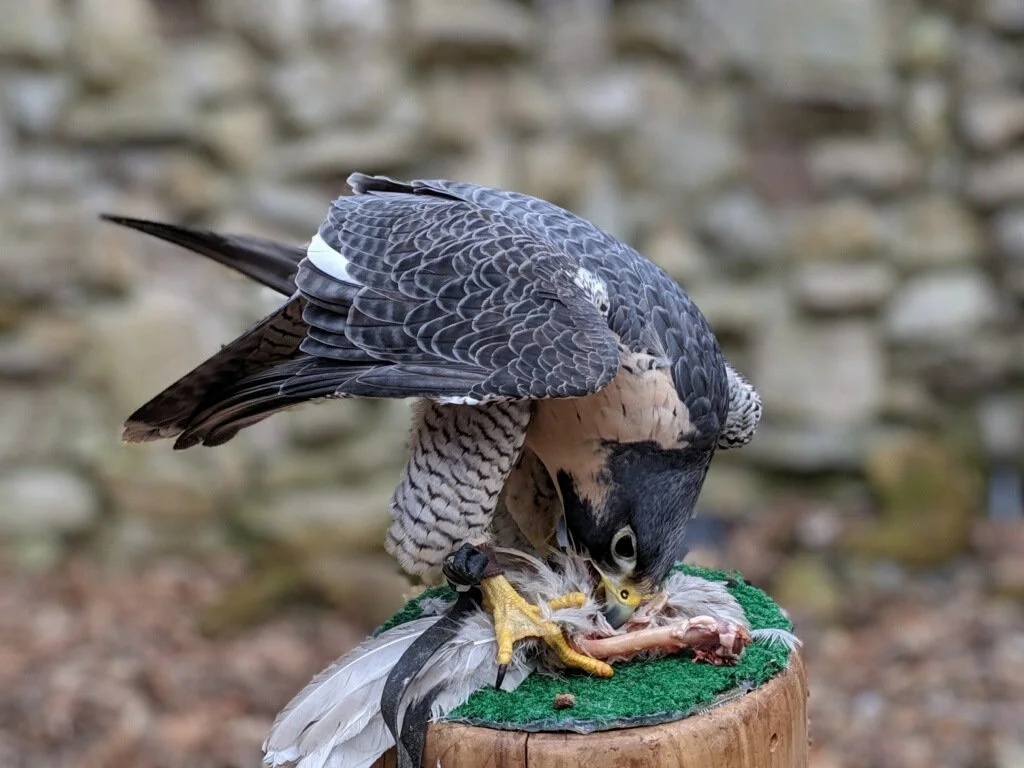Old-Growth Gazette: March 2022
Our mission is to create experiences which connect people with nature, motivate them to lead sustainable lives, and take action to protect wildlife and wild places. We look forward to having you join us on this journey!
Click any button below for a specific topic OR scroll through the page to read the entire newsletter.
Small-mouthed salamander; photo by Alex Arwood
Nature News: Salamander Surveys
by Wesselman Woods volunteer, Paul H.
The day had been warm for the end of February. It rained earlier and, since a cold front was forecast to arrive that evening, there was beginning to be chill in the air. However, this wasn't putting a damper on the 20 or so individuals waiting to catch a glimpse of the normally elusive amphibians known as salamanders. Thus, the start of the annual salamander survey at Wesselman Woods had begun.
The intrepid group of individuals who showed up that evening were hoping to see some of the salamanders that call Wesselman Woods and Wesselman Park their home. This warm, damp evening was a perfect time to find these animals traveling from their winter homes to temporary ponds where they would mate and lay their eggs.
Salamander is Greek for “fire lizard” and have long slender bodies, blunt snouts, and a tail. Typically, they undergo a larval stage that can last from a few days to several years. They range in size from one inch to the 6-foot Chinese giant salamander and can weigh up to 140 pounds. Because they are amphibians, they can breathe through their lungs, gills, or skin. They typically forage for worms and insects depending on where they live. During daylight hours these shy amphibians can be found hiding under logs, rocks, or leaf litter.
Interestingly, they have the ability to regrow missing limbs or a tail. They will sometimes drop their tails to escape predators. This detached body part serves as a distraction and will wriggle around for a time while the salamander scampers off to safety.
Measuring salamanders
Of the 23 species of salamanders found in Indiana (about 740 worldwide) there are potentially five species found in this part of Indiana: Marbled Salamanders, Small-Mouthed Salamanders, Northern Slimy Salamanders, Spotted Salamanders, and Tiger Salamanders.
Marbled Salamanders are large, stout black salamanders with marbled white or silvery spots. They live from about 4 to 10 years. Adults breed and lay eggs in the late fall/early winter. The rest of the salamander species found in our area lay their eggs in the spring.
Small-Mouthed Salamanders are gray or black dorsally with lighter gray mottling on their sides. They range from 1.5 to 2 inches in length. Eggs are laid individually or in small jelly-like masses and attach to vegetation or debris in shallow water. They live under boards or logs near ponds or swamps and have a life span of 8 to 10 years.
Northern Slimy Salamanders live 5 to 10 years. They are mostly black with silver-white spots and are typically 5 to 7 inches long. True to their name, they release sticky secretions through glands in their skin as defense mechanism. They prefer to live on steep, moist, rocky slopes under logs, stone debris, and in the abandoned burrows of other small animals.
Spotted Salamanders can live up to 20 years. This large, stocky animal has gray or black coloring on their back and large conspicuous yellow-orange spots. Their eggs are found in large globular masses and can host a symbiotic alga that turns the embryos and eggs green.
Our first round of salamander adventurers
The largest salamander living in the forests, marshes, and grasslands of Southern Indiana is the Tiger Salamander. They have long brown to olive-colored bodies with an irregular pattern of yellow blotches. They can reach up to 10 inches in length and their life span ranges from 12 to 16 years.
The adventurers who showed up that evening for the salamander survey were not disappointed. Over a hundred of these miniature “fire lizards” were counted and many of the amateur scientists left with memories that they won’t soon forget.
To learn more about the research happening at Wesselman Woods, visit our Research page.
Upcoming Events
Earth Day Celebrations at Howell Wetlands・April 22-23
Join the Wesselman Woods team at our second property, Howell Wetlands!
Location: 1400 S Tekoppel Ave, Evansville, IN 47712
Each year, Wesselman Woods (WW) celebrates the planet with a community event. In 2022, we are taking the party to Howell Wetlands (HW) on Friday, April 22, and Saturday, April 23, from 10 a.m. to 2 p.m. each day.
This free event will include educational activities, guided hikes, animal encounters, and special community guests. Local food trucks will also be in attendance. Find out more.
Going Green on the Green Golf Scramble Benefit・Monday, April 25
We are looking to align with environmentally conscientious businesses who are eager to help "drive" the community to experience unique environmental opportunities amidst the "lungs" of Evansville⎯Wesselman Woods!
Interested in securing a spot for your golf team? See our sponsorship sheet!
Keep Evansville Beautiful presents Arbor Day at Wesselman Woods・April 29
Free Tree Giveaway and Free Admission to Wesselman Woods!
Keep Evansville Beautiful (KEB) is continuing their tradition of giving away free trees to the community this year!
Native trees sourced from Bur Oak Tree Service and Nursery will be given away outside the main gate of Wesselman Woods Nature Preserve (WW) on Friday, April 29, from 11 a.m. to 6 p.m., while supplies last. This event is a partnership between KEB, WW, the Evansville Department of Urban Forestry, On the Spot Utility Resources LLC, and CenterPoint Energy. Find out more.
Eco-Learning
2022 Summer Camps
Summer Camps return to Wesselman Woods in 2022. See the themes and dates below. Register today before the seats fill up!
Forest Engineers: June 6 – June 10, Ages 6-9
Explore and discover the incredible engineers of the natural world with us at Wesselman Woods. We will spend the week marveling over spider webs, beaver dams, bird nests, plant and animal structures, and so much more while we recreate these natural designs in creative and interactive ways.
Junior Forest League - Master Naturalist: June 20 – June 24, Ages 9-12
Calling all budding naturalists! At the end of this camp week, campers will have completed the requirements needed to become a certified Junior Indiana Master Naturalist! Campers will participate in fun hands-on experiences to learn about Indiana’s plants, water, soils, wildlife, and natural history, along with taking part in service projects.
Camp Wesselmón: July 11 – July 15, Ages 6-10
“Gotta catch ‘em all at Wesselman Woods!” Come discover real world Pokemon through animal encounters and forest exploration. Each day has a collectible item, along with our Pokedex we will fill out every day.
Camp Creepy: July 25 - July 29, Ages 9-12
They're creepy and they're kooky, mysterious and spooky, oh the oddities of Wesselman Woods! This week will be filled with all the things to make your skin crawl. We will explore a wide range of eerie topics, from arachnids and insects to skeletons and scary stories. Perfect for those interested in the strange and abnormalities of the world.
Izzy the Peregrine Falcon enjoys a meal
Mews News
If birds eat other birds, does that make them cannibals?
Peregrine falcons eat a wide variety of birds, ranging from small songbirds to large cranes and geese. Often, people wonder if we could consider this cannibalism but the answer is "no". Cannibalism in raptors like the peregrine falcon is relatively rare. When it does happen, the incidences are usually centered around dependent nestlings and limited resources. Brood reduction can help the stronger siblings survive or even help the parents get through a tough breeding season.
By the book, cannibalism is an instance in which one animal eats another of its own species. So, a bird eating another bird would be like a mammal eating another mammal (e.g. a coyote eating a rabbit) or a reptile eating a reptile (e.g. a kingsnake eating a rattler). In these examples, none of the animals eating their own kind.
However, animals can turn to cannibalism when times are hard and resources (like food or space) are scarce. It can also be useful when animals are interested in ensuring that their genes make it to the next generation! That being said, cannibalism does not form the basis of any animal's diet. (That would be very detrimental to the species!)
Well-known examples of animal cannibals are black widows and praying mantises, where the female will eat their protein-rich mate to support egg development. Other examples:
Some juvenile insects eat their own siblings in the same clutch.
Tiger salamanders are known to dine on non-related tiger salamanders.
Rabbits are known to eat weak or sick kits.
And, reminiscent of lions, male American red squirrels can kill and eat the offspring of other males.

















